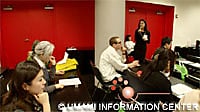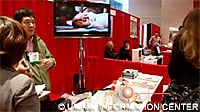Umami Lecture "How to Use Umami Technique" in International Restaurant and Foodservice Show of New York
April 2013
The International Restaurant and Foodservice Show of New York, one of the biggest food shows, was held at Javits Convention Center, NY, USA, on March 3rd and 4th, 2013.
Following the 2012 event, the Umami Information Center organized the Umami Lecture at the Japan Pavilion. For this year's theme HOW TO USE UMAMI TECHNIQUE, we invited two lecturers: Chef Chikara Sono, executive chef of the popular Kyo Ya, NYC and Ms. Hiroko Shimbo who has been teaching Japanese cuisine at culinary schools in the States for many years.
Chef Sono explained what umami is and demonstrated how to make kombu dashi with kombu and ichiban dashi using kombu and katsuobushi. After tasting two kinds dashi, he explained that glutamate imparted by kombu enhances umami in vegetables and heightens the taste. Also adding katsuobushi into kombudashi enables intensive strengthening of umami thanks to the synergistic effect of glutamate and inosinate.
He presented some samples: cherry tomato soaked in kombu dashi and maitake mushroom soaked with kombu dashi using bonito flakes as a garnish. During the demonstration on how to make dashi by sea bream, he explained that fresh ingredients for dashi are expensive and most Japanese households use MSG (Monosodium Glutamate) instead. In his final message, he explained that umami is the fifth basic taste along with sweetness, sourness, saltiness and bitterness. Japanese people utilize umami to complement the flavor of ingredients. In the next session, Ms Shimbo explained the facts of glutamate scores in kombu, tomato and cheese, and the glutamate richness with small about of other taste component in kombudashi compared with chicken stock; therefore, dashi is the most suitable way of adding umami to a dish. She mentioned how Japanese cuisine made progress by cultivating umami. She also talked about the glutamate in mother's milk, saying human beings are able to know umami immediately after birth and umami is the universal taste. She finished by saying that by using umami, we are able to reduce salt and calories and thus it will help to solve social issues of obesity and high blood pressure in the US for the future.
This workshop gave the impression that the audience understood how to apply umami to various dishes and that umami will help to prevent obesity and other lifestyle related diseases.
We prepared our umami leaflet for handouts and showed the newly produced video clips featuring our event in Fukuoka, as well as the ingredients for dashi (kombu and katsuobushi).
They received much attention from the audience.
In the event, although we have been educating about umami since 2007, we were surprised to learn that the interest in umami is increasing every year. We will continue to educate about umami to widen its popularity.





